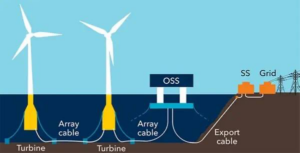
Energy industry expert and assurance firm DNV has partnered up with 25 industry giants in a Joint Industry Project (JIP) aimed at enhancing technology development for floating offshore wind substations, with particular attention to how export cables and topside equipment tolerate movements of a floating substructure.
The objective is to align industry best-practice allowing for accelerated technology development and to close gaps in available substation standards enabling scaling of floating offshore wind with an acceptable level of commercial, technical, health, safety and environmental risks.
The following companies have joined as partners: ABB, Aibel, Aker Solutions, Atlantic offshore energy, BP, EDF, Elia Group, Equinor, Falck Renewables, GE Renewable Energy, Gicon, Hitachi Energy, IV One, Oil states industries, Orsted, Prysmian, RWE, Saipem, Shell/Eolfi, Siemens Energy, SSE Renewables, Technip Energies, Terna Plus Srl, Total Energies, Worley.
“DNV continuously works together with the industry to develop up to date standards and recommended practices tailored to the demands of the advancing renewables market. One of the most-widely used documents is the DNV-ST-0145 standard which provides the technical requirements for the certification of electrical offshore substations,” DNV said.
“For its latest update more than 500 industry comments were reflected in this standard which is of increased importance as a growing number of projects pursue new concepts. The results of this JIP will be used to update the standard making it applicable for floating offshore substations.”DNV added.
Back in November 2021, when DNV first said it was looking for partners to launch a new Joint Industry Project (JIP) for floating offshore substations, the company said that floating substations were viewed as a key enabler for the next phase of the emerging floating wind industry, where the turbines are deployed in deeper waters, further from shore than standard fixed-bottom turbines.
DNV’s latest Energy Transition Outlook Report forecasts that by 2050, the installed floating wind capacity will have grown to over 260 GW and that the technology will reach commercial-scale deployment in the next 15 years.
